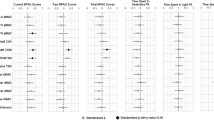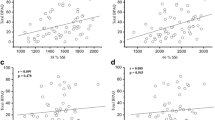Abstract
Summary
Osteoporosis is common, and physical activity is important in its prevention and treatment. Of the categories of historical physical activity (PA) examined, we found that weight-bearing and very hard physical activity had the strongest relationships with areal bone mineral density (aBMD) throughout growth and into adulthood, while for measures of strength, only grip strength proved to be an independent predictor of aBMD.
Purpose/introduction
To examine relationships between aBMD (total body, lumbar spine, proximal femur, tibial shaft, distal radius) and estimates of historical PA, current strength, and cardiovascular fitness in adult premenopausal women.
Methods
One hundred fifty-two adult premenopausal women (40 ± 9.6 years) undertook aBMD (dual-energy X-ray absorptiometry (DXA)) and completed surveys to estimate historical physical activity representative of three decades (Kriska et al. [1]), while subsets underwent functional tests of isokinetic strength (hamstrings and quadriceps), grip strength (hand dynamometer), and maximum oxygen uptake (MaxV02; cycle ergometer). Historical PA was characterized by demand (metabolic equivalents, PA > 3 METS; PA > 7 METS) and type (weight-bearing; high impact).
Results
Significant positive independent predictors varied by decade and site, with weight-bearing exercise and PA > 3 METS significant for the tibial shaft (10–19 decade) and only PA > 7 METS significant for the final two decades (20–29 and 30–39 years; total body and total hip). A significant negative correlation between high impact activity and tibial shaft aBMD appeared for the final decade. For strength measures, only grip strength was an independent predictor (total body, total hip), while MaxV02 provided a significant independent prediction for the tibial shaft.
Conclusions
Past PA > 7 METS was positively associated with aBMD, and such activity should probably constitute a relatively high proportion of all weekly PA to positively affect aBMD. The findings warrant more detailed investigations in a prospective study, specifically also investigating the potentially negative effects of high impact PA on tibial aBMD.
Similar content being viewed by others
Abbreviations
- aBMD:
-
Areal bone mineral density
- BMC:
-
Bone mineral content
- BMI:
-
Body mass index
- CFQ:
-
Calcium frequency questionnaire
- DXA:
-
Dual-energy X-ray absorptiometry
- GRF:
-
Ground reaction forces
- HLAQ:
-
Historical Leisure Activity Questionnaire
- MaxV02 :
-
Maximum oxygen uptake
- METS:
-
Metabolic equivalents
- OI:
-
Osteogenic index
References
Nowson CS, Green AJ, Wark JD (1995) Limitations of dietary calcium assessment in female twins of different ages. In Burckhardt P and Heaney RP(eds) Challenges of Modern Medicine 7:97–104
Lei SF, Chen Y, Xiong DH, Li LM, Deng HW (2006) Ethnic difference in osteoporosis-related phenotypes and its potential underlying genetic determination. J Musculoskelet Neuronal Interac 6(1):36–46
Nikander R, Kannus P, Dastidar P, Hannula M, Harrison L, Cervinka T, Narra NG, Akltour R, Arola T, Eskola H, Soimakallio S, Heinonen A, Hyttinen J, Sievanen H (2009) Targeted exercises against hip fragility. Osteoporos Int 20(8):1321–1328
Kannus P, Haapasalo H, Sankelo M, Sievänen H, Pasanen M, Heinonen A, Oja P, Vuori I (1995) Effect of the starting age of physical activity on bone mass in the dominant arm of tennis and squash players. Ann Intern Med 123:27–31
Sabatier JP, Guaydier-Souquières G, Laroche D, Benmalek A, Fournier L, Guillon-Metz F, Delavenne J, Ay D (1996) Bone mineral acquisition during adolescence and early adulthood: a study in 574 healthy females 10–24 years of age. Osteoporos Int 6(2):141–148
Recker RR, Davies KM, Hinders SM, Heaney RP, Stegman MR, Kimmel DB (1992) Bone gain in young adult women. Jama 268(17):2403–2408
Nordstrom A, Olsson T, Nordstrom P (2005) Bone gained from physical activity and lost through detraining: a longitudinal study in young males. Osteoporos Int 16(7):835–841
Welch JM, Rosen CJ (2005) Older women track and field athletes have enhanced calcaneal stiffness. Osteoporos Int 16(8):871–878
Pollock NK, Laing EM, Modlesky CM, O'Connor PJ, Lewis RD (2006) Former college artistic gymnasts maintain higher BMD: a nine-year follow-up. Osteoporos Int 17(11):1691–1697
Karlsson MK, Linden C, Karlsson C, Johnell O, Obrant K, Seeman E (2002) Exercise during growth and bone mineral density and fractures in old age. Lancet 355:469–470
Greendale GA, Barrett-Connor E, Edelstein S, Ingles S, Haile R (1995) Lifetime leisure exercise and osteoporosis. The Rancho Bernardo study. Am J Epidemiol 141(10):951–959
Rideout CA, McKay HA, Barr SI (2006) Self-reported lifetime physical activity and areal bone mineral density in healthy postmenopausal women: the importance of teenage activity. Calcif Tissue Int 79(4):214–222
Ulrich CM, Georgiou CC, Gillis DE, Snow CM (1999) Lifetime physical activity is associated with bone mineral density in premenopausal women. J Womens Health 8(3):365–375
Ishikawa K, Ohta T, Tahara Y, Suzuki T (2000) The relationship between spinal and appendicular bone mass modified by physical, historical, and lifestyle factors. J Bone Miner Metab 18(3):170–175
Brahm H, Mallmin H, Michaelsson K, Strom H, Ljunghall S (1998) Relationships between bone mass measurements and lifetime physical activity in a Swedish population. Calcif Tissue Int 62(5):400–412
Daly RM, Bass SL (2005) Lifetime sport and leisure activity participation is associated with greater bone size, quality and strength in older men. Osteoporos Int 17(8):1258–67
van Mechelen W, Twisk JW, Kemper HC, Snel J, Post GB (1999) Longitudinal relationships between lifestyle and cardiovascular and bone health status indicators in males and females between 13 and 27 years of age: a review of findings from the Amsterdam growth and health longitudinal study. Public Health Nutr 2(3A):419–427
Van Langendonck L, Lefevre J, Claessens AL, Thomis M, Philippaerts R, Delvaux K, Lysens R, Renson R, Vanreusel B, Vanden Eynde B, Dequeker J, Beunen G (2003) Influence of participation in high-impact sports during adolescence and adulthood on bone mineral density in middle-aged men: a 27-year follow-up study. Am J Epidemiol 158(6):525–33
Rikkonen T, Tuppurainen M, Kröger H, Jurvelin J, Honkanen R (2006) Distance of walking in childhood and femoral bone density in perimenopausal women. Eur J Appl Physiol 5:509–515
MacKelvie KJ, Khan KM, McKay HA (2002) Is there a critical period for bone response to weight-bearing exercise in children and adolescents? A systematic review. Br J Sports Med 36(4):250–257
Kohrt WM, Barry DW, Schwartz RS (2009) Muscle forces or gravity: what predominates mechanical loading on bone? Med Sci Sports Exerc 41(11):2050–2055
Greenway KG, Walkley JW, Rich PA (2012) Does long-term swimming participation have a deleterious effect on the adult female skeleton? Eur J Appl Physiol 112(9):3217–25
Kriska AM, Sandler RB, Cauley JA, LaPorte RE, Hom DL, Pambianco G (1988) The assessment of historical physical activity and its relation to adult bone parameters. Am J Epidemiol 127(5):1053–1063
Ainsworth BE, Haskell WL, Whitt MC, Irwin ML, Swartz AM, Strath SJ, Leon AS (2000) Compendium of physical activities: an update of activity codes and MET intensities. Med Sci Sports Exerc 32(9 Suppl):S498–504
Lu LJW, Nayeem F, Anderson KE, Grady JJ, Nagamani M (2009) Lean body mass, not estrogen or progesterone, predicts peak bone mineral density in premenopausal women. J Nutr 139(2):250–256
Wang MC, Bachrach LK, Van Loan M, Hudes M, Flegal KM, Crawford PB (2005) The relative contributions of lean tissue mass and fat mass to bone density in young women. Bone 37(4):474–481
Makovey J, Naganathan V, Sambrook P (2005) Gender differences in relationships between body composition components, their distribution and bone mineral density: a cross-sectional opposite sex twin study. Osteoporos Int 16(12):1495–1505
Reid IR (2002) Relationships among body mass, its components, and bone. Bone 31(5):547–555
Travison TG, Araujo AB, Esche GR, Beck J, McKinlay JB (2008) Lean mass and not fat mass is associated with male proximal femur strength. J Bone Miner Res 23(2):189–198
Miller LE, Nickols-Richardson SM, Wootten DF, Ramp WK, Herbert WG (2004) Relationships among bone mineral density, body composition, and isokinetic strength in young women. Calcif Tissue Int 74(3):229–235
Sayers A, Mattocks C, Deere K, Ness A, Riddoch C, Tobias JH (2011) Habitual levels of vigorous, but not moderate or light, physical activity is positively related to cortical bone mass in adolescents. J Clin Endocrinol Metab 96(5): Epub 2011 Feb doi:E793-802
Shedd KM, Hanson KB, Alekel DL, Schiferl DJ, Hanson LN, Van Loan MD (2007) Quantifying leisure physical activity and its relation to bone density and strength. Med Sci Sports Exerc 39(12):2189–2198
Bayramoğlu M, Sözaym S, Karataş M, Kilinç S (2005) Relationships between muscle strength and bone mineral density of three body regions in sedentary postmenopausal women. Rheumatol Int 25(7):513–517
Ribom E, Ljunggren Ö, Piehl-aulin K, Ljunghall S, Bratteby L-E, Samuelson G, Mallmin H (2004) Muscle strength correlates with total body bone mineral density in young women but not in men. Scand J Med Sci Sports 14(1):24–29
Owings TM, Pavol MJ, Grabiner MD (2002) Lower extremity muscle strength does not independently predict proximal femur bone mineral density in healthy older adults. Bone 30(3):515–520
Madsen OR, Schaadt O, Bliddal H, Egsmose C, Sylvest J (1993) Relationship between quadriceps strength and bone mineral density of the proximal tibia and distal forearm in women. J Bone Miner Res 8(12):1439–1444
Vico L, Pouget JF, Calmels P, Chatard JC, Rehailia M, Minaire P, Alexandre C (1995) The relations between physical ability and bone mass in women aged over 65 years. J Bone Miner Res 10(3):374–383
Sööt T, Jürimäe T, Jürimäe J, Gapeyeva H, Pääsuke M (2005) Relationship between leg bone mineral values and muscle strength in women with different physical activity. J Bone Miner Metab 23(5):401–406
Bevier WC, Wiswell RA, Pyka G, Kozak KC, Newhall KM, Marcus R (1989) Relationship of body composition, muscle strength, and aerobic capacity to bone mineral density in older men and women. J Bone Miner Res 4(3):421–432
Kritz-Silverstein D, Barrett-Connor E (1994) Grip strength and bone mineral density in older women. J Bone Miner Res 9(1):45–51
Chan DC, Lee WT, Lo DH, Leung JC, Kwok AW, Leung PC (2008) Relationship between grip strength and bone mineral density in healthy Hong Kong adolescents. Osteoporos Int 19(10):1485–1495
Di Monaco M, Di Monaco R, Manca M, Cavanna A (2000) Handgrip strength is an independent predictor of distal radius bone mineral density in postmenopausal women. Clin Rheumatol 19(6):473–476
Frank AW, Lorbergs AL, Chilibeck PD, Farthin JP, Kontulainen SA (2010) Muscle cross sectional area and grip torque contraction types are similarly related to pQCT derived bone strength indices in the radii of older healthy adults. J Musculoskelet Neuronal Interact 10(2):136–141
Pocock NA, Eisman JA, Yeates MG, Sambrook PN, Eberl S (1986) Physical fitness is a major determinant of femoral neck and lumbar spine bone mineral density. J Clin Invest 78(3):618–621
Stewart KJ, Bacher AC, Hees PS, Tayback M, Ouyang P, Jan de Beur S (2005) Exercise effects on bone mineral density relationships to changes in fitness and fatness. Am J Prev Med 28(5):453–460
Hind K, Truscott JG, Evans JA (2006) Low lumbar spine bone mineral density in both male and female endurance runners. Bone 39(4):880–885
Haapasalo H, Kontulainen S, Sievänen H, Kannus P (2000) Exercise-induced bone gain is due to enlargement in bone size without a change in volumetric bone density: a peripheral quantitative computed tomography study of the upper arms of male tennis players. Bone 27(3):351–357
Acknowledgments
The authors wish to express their appreciation to the all of the participants and to the Shepherd Foundation of Victoria for funding that supported the project.
Author information
Authors and Affiliations
Corresponding author
Ethics declarations
Conflict of interest
Kathleen Greenway, Jeff Walkley, and Peter Rich declare that they have no conflict of interest.
Ethical approval
All procedures performed in studies involving human participants were in accordance with the ethical standards of the institutional and/or national research committee and with the 1964 Helsinki Declaration and its later amendments or comparable ethical standards.
All procedures were approved by the RMIT University Human Ethics Committee, and written informed consent obtained from all participants in the study.
Rights and permissions
About this article
Cite this article
Greenway, K.G., Walkley, J.W. & Rich, P.A. Relationships between self-reported lifetime physical activity, estimates of current physical fitness, and aBMD in adult premenopausal women. Arch Osteoporos 10, 34 (2015). https://doi.org/10.1007/s11657-015-0239-y
Received:
Accepted:
Published:
DOI: https://doi.org/10.1007/s11657-015-0239-y




